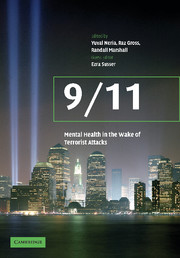Book contents
- Frontmatter
- Contents
- Acknowledgments
- Editors brief bio
- List of contributors
- Foreword
- Part I Introduction
- Part II The psychological aftermath of 9/11
- Part III Reducing the burden: community response and community recovery
- Part IV Outreach and intervention in the wake of terrorist attacks
- Part IV A New York area
- Part IV B Washington, DC
- 24 The mental health response to the 9/11 attacks on the Pentagon
- 25 Learning lessons from the early intervention response to the Pentagon
- Part IV C Prolonged-exposure treatment as a core resource for clinicians in the community: dissemination of trauma knowledge post-disaster
- Part V Disasters and mental health: perspectives on response and preparedness
- Index
24 - The mental health response to the 9/11 attacks on the Pentagon
from Part IV B - Washington, DC
Published online by Cambridge University Press: 27 October 2009
- Frontmatter
- Contents
- Acknowledgments
- Editors brief bio
- List of contributors
- Foreword
- Part I Introduction
- Part II The psychological aftermath of 9/11
- Part III Reducing the burden: community response and community recovery
- Part IV Outreach and intervention in the wake of terrorist attacks
- Part IV A New York area
- Part IV B Washington, DC
- 24 The mental health response to the 9/11 attacks on the Pentagon
- 25 Learning lessons from the early intervention response to the Pentagon
- Part IV C Prolonged-exposure treatment as a core resource for clinicians in the community: dissemination of trauma knowledge post-disaster
- Part V Disasters and mental health: perspectives on response and preparedness
- Index
Summary
The views expressed in this article are those of the authors and do not reflect the official policy or position of the Department of the Army, the Uniformed Services University of the Health Sciences, the Department of Defense or the US Government.
Introduction
The prominent images of September 11, 2001, focus on the World Trade Center falling, the firemen digging through the rubble, and the grieving in New York City. The crash of the plane in Pennsylvania has been immortalized by the brave actions of the passengers, and the enduring and inspiring “Let's Roll” battle cry. The story of the plunge into the Pentagon of the third plane, and the immediate valiant response of the workers there, is less well known. The medical and mental health personnel provided a superb and relatively comprehensive response to the disaster in Northern Virginia. Yet that story was dwarfed by the larger tragedy in New York. This chapter hopes to highlight the work at the Pentagon and the surrounding community.
Shortly after two airplanes smashed into the World Trade Center on the morning of September 11th, the American Airlines 77 plane hit the south side of the Pentagon. Those in the affected wedge heard a boom, and depending on how close they were, saw, smelled, and heard smoke and fire. Many had to struggle to get out through fireballs of jet fuel and dense smoke. Some even scrambled over the burning plane to safety. Many returned numerous times to aid others.Others tried to get back in, but could not, because of the intense raging fire.
- Type
- Chapter
- Information
- 9/11: Mental Health in the Wake of Terrorist Attacks , pp. 427 - 445Publisher: Cambridge University PressPrint publication year: 2006
- 1
- Cited by



